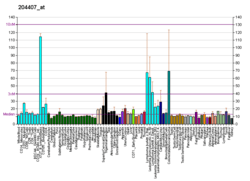TTF2
Transcription termination factor 2 is a protein that in humans is encoded by the TTF2 gene.[5][6]
This gene encodes a member of the SWI2/SNF2 family of proteins, which play a critical role in altering protein-DNA interactions. The encoded protein has been shown to have dsDNA-dependent ATPase activity and RNA polymerase II termination activity. This protein interacts with cell division cycle 5-like, associates with human splicing complexes, and plays a role in pre-mRNA splicing.[6]
Interactions
References
- 1 2 3 GRCh38: Ensembl release 89: ENSG00000116830 - Ensembl, May 2017
- 1 2 3 GRCm38: Ensembl release 89: ENSMUSG00000033222 - Ensembl, May 2017
- ↑ "Human PubMed Reference:".
- ↑ "Mouse PubMed Reference:".
- ↑ Liu M, Xie Z, Price DH (Nov 1998). "A human RNA polymerase II transcription termination factor is a SWI2/SNF2 family member". J Biol Chem. 273 (40): 25541–4. doi:10.1074/jbc.273.40.25541. PMID 9748214.
- 1 2 "Entrez Gene: TTF2 transcription termination factor, RNA polymerase II".
- ↑ Leonard, Deana; Ajuh Paul; Lamond Angus I; Legerski Randy J (Sep 2003). "hLodestar/HuF2 interacts with CDC5L and is involved in pre-mRNA splicing". Biochem. Biophys. Res. Commun. United States. 308 (4): 793–801. doi:10.1016/S0006-291X(03)01486-4. ISSN 0006-291X. PMID 12927788.
Further reading
- Girdham CH, Glover DM (1991). "Chromosome tangling and breakage at anaphase result from mutations in lodestar, a Drosophila gene encoding a putative nucleoside triphosphate-binding protein". Genes Dev. 5 (10): 1786–99. doi:10.1101/gad.5.10.1786. PMID 1916263.
- Hara R, Selby CP, Liu M, et al. (1999). "Human transcription release factor 2 dissociates RNA polymerases I and II stalled at a cyclobutane thymine dimer". J. Biol. Chem. 274 (35): 24779–86. doi:10.1074/jbc.274.35.24779. PMID 10455150.
- Strausberg RL, Feingold EA, Grouse LH, et al. (2003). "Generation and initial analysis of more than 15,000 full-length human and mouse cDNA sequences". Proc. Natl. Acad. Sci. U.S.A. 99 (26): 16899–903. Bibcode:2002PNAS...9916899M. doi:10.1073/pnas.242603899. PMC 139241. PMID 12477932.
- Leonard D, Ajuh P, Lamond AI, Legerski RJ (2003). "hLodestar/HuF2 interacts with CDC5L and is involved in pre-mRNA splicing". Biochem. Biophys. Res. Commun. 308 (4): 793–801. doi:10.1016/S0006-291X(03)01486-4. PMID 12927788.
- Jiang Y, Liu M, Spencer CA, Price DH (2004). "Involvement of transcription termination factor 2 in mitotic repression of transcription elongation". Mol. Cell. 14 (3): 375–85. doi:10.1016/S1097-2765(04)00234-5. PMID 15125840.
- Colland F, Jacq X, Trouplin V, et al. (2004). "Functional proteomics mapping of a human signaling pathway". Genome Res. 14 (7): 1324–32. doi:10.1101/gr.2334104. PMC 442148. PMID 15231748.
- Jiang Y, Price DH (2006). "Rescue of the TTF2 knockdown phenotype with an siRNA-resistant replacement vector". Cell Cycle. 3 (9): 1151–3. doi:10.4161/cc.3.9.1151. PMID 15467445.
- Gerhard DS, Wagner L, Feingold EA, et al. (2004). "The status, quality, and expansion of the NIH full-length cDNA project: the Mammalian Gene Collection (MGC)". Genome Res. 14 (10B): 2121–7. doi:10.1101/gr.2596504. PMC 528928. PMID 15489334.
- Gregory SG, Barlow KF, McLay KE, et al. (2006). "The DNA sequence and biological annotation of human chromosome 1". Nature. 441 (7091): 315–21. Bibcode:2006Natur.441..315G. doi:10.1038/nature04727. PMID 16710414.
This article is issued from
Wikipedia.
The text is licensed under Creative Commons - Attribution - Sharealike.
Additional terms may apply for the media files.




